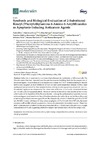Identificador persistente para citar o vincular este elemento:
https://accedacris.ulpgc.es/jspui/handle/10553/72804
| Título: | Synthesis and Biological Evaluation of 2-Substituted Benzyl-/Phenylethylamino-4-amino-5-aroylthiazoles as Apoptosis-Inducing Anticancer Agents | Autores/as: | Oliva, Paola Onnis, Valentina Balboni, Elisa Hamel, Ernest Estévez-Sarmiento, Francisco Quintana Aguiar, José Martín Estévez Rosas, Francisco Jesús Brancale, Andrea Ferla, Salvatore Manfredini, Stefano Romagnoli, Romeo |
Clasificación UNESCO: | 320713 Oncología | Palabras clave: | Antiproliferative Activity Apoptosis Microtubules Pharmacophoric Merging Structure-Activity Relationship |
Fecha de publicación: | 2020 | Publicación seriada: | Molecules | Resumen: | Induction of apoptosis is a common chemotherapeutic mechanism to kill cancer cells The thiazole system has been reported over the past decades as a building block for the preparation of anticancer agents. A novel series of 2-arylalkylamino-4-amino-5-(3',4',5'-trimethoxybenzoyl)-thiazole derivatives designed as dual inhibitors of tubulin and cyclin-dependent kinases (CDKs) were synthesized and evaluated for their antiproliferative activity in vitro against two cancer cell lines and, for selected highly active compounds, for interactions with tubulin and cyclin-dependent kinases and for cell cycle and apoptosis effects. Structure-activity relationships were elucidated for various substituents at the 2-position of the thiazole skeleton. Among the synthesized compounds, the most active analogues were found to be the p-chlorobenzylamino derivative 8e as well as the p-chloro and p-methoxyphenethylamino analogues 8f and 8k, respectively, which inhibited the growth of U-937 and SK-MEL-1 cancer cell lines with IC50 values ranging from 5.7 to 12.2 μM. On U-937 cells, the tested compounds 8f and 8k induced apoptosis in a time and concentration dependent manner. These two latter molecules did not affect tubulin polymerization (IC50 > 20 μM) nor CDK activity at a single concentration of 10 μM, suggesting alternative targets than tubulin and CDK for the compounds. | URI: | https://accedacris.ulpgc.es/handle/10553/72804 | ISSN: | 1420-3049 | DOI: | 10.3390/molecules25092177 | Fuente: | Molecules (Basel, Switzerland ) [EISSN 1420-3049], v. 25 (9), (Mayo 2020) |
| Colección: | Artículos |
Los elementos en ULPGC accedaCRIS están protegidos por derechos de autor con todos los derechos reservados, a menos que se indique lo contrario.
